#white terrazzo counter
Photo
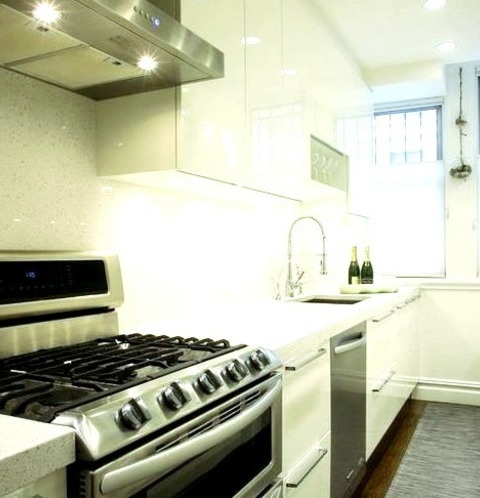
New York Enclosed
Enclosed kitchen - mid-sized modern galley medium tone wood floor enclosed kitchen idea with an undermount sink, flat-panel cabinets, white cabinets, stainless steel appliances, no island, terrazzo countertops, white backsplash and stone tile backsplash
#compact kitchen ideas#white galley kitchen ideas#white terrazzo counter#galley kitchen ideas#all white compact kitchen
0 notes
Photo

Modern Kitchen - Enclosed
Inspiration for a mid-sized modern galley medium tone wood floor enclosed kitchen remodel with an undermount sink, flat-panel cabinets, white cabinets, stainless steel appliances, no island, terrazzo countertops, white backsplash and stone tile backsplash
#white galley kitchen#white terrazzo counter#white galley kitchen ideas#modern compact kitchen#all white kitchen ideas
0 notes
Photo

Modern Kitchen - Kitchen
#Mid-sized modern galley enclosed kitchen idea with a medium tone wood floor#an undermount sink#flat-panel cabinets#white cabinets#stainless steel appliances#no island#terrazzo countertops#a white backsplash#and a backsplash made of stone tile. white terrazzo countertop#white galley kitchen ideas#compact kitchen ideas#dark wood kitchen flooring#galley kitchen ideas#modern compact kitchen#white terrazzo counter
0 notes
Photo

Enclosed - Transitional Kitchen
Large transitional l-shaped enclosed kitchen plan with terrazzo worktops, a drop-in sink, flat-panel cabinets, white cabinets, black backsplash, white backsplash, mosaic tile backsplash, stainless steel appliances, and an island.
#terrazzo kitchen counter#kitchen white cabinet#kitchen black backsplash#glossy wood floors#kitchen backsplash black#built in microwave shelf#black mosaic backsplash
0 notes
Photo

Kitchen Great Room
#Large mid-century modern galley terrazzo floor and white floor open concept kitchen photo with an integrated sink#flat-panel cabinets#white cabinets#quartz countertops#gray backsplash#stainless steel appliances#an island and white countertops quartz counters#montgomery countertops#terrazzo#window facade
0 notes
Text
Mississauga Kitchen Renovation Trends: What Contractors Need to Know
New kitchen design styles are entering the renovation market. Kitchens are no longer only useful living areas; instead, inhabitants are embracing a more styled and artistic approach to modern cooking.
Let us look at the top trends in kitchen renovations that you can expect in your house with the help of kitchen renovation contractors Mississauga.
Dark Countertops
Bright white kitchens have been fashionable for several years, but designers expect a shift toward dark counters. Black granite and cement countertops add depth to the modern kitchen space. Whether you choose an industrial or farmhouse aesthetic, dark worktops may be a timeless makeover worth discussing with your Kitchen renovation contractors Mississauga in the future.
Smooth Curves
As design trends shift, there is an increased desire for multidimensional environments. Smooth curves in countertops and kitchen tables are elevating the look of kitchens. If you meet with a custom renovator, you can talk about how to incorporate carefully engineered curvature into your kitchen to create a sense of movement.
Colourful Terrazo
Terrazzo is a composite material that was often used in older homes for countertops and floors. However, colourful terrazzo is making a resurgence as a design element for exotic kitchen cabinets and floors. Consider using colourful terrazzo instead of typical granite countertops to give your area a quirky throwback vibe.
However, for an even more durable surface, our flooring installation crew provides terrazzo-like epoxy floor types in a variety of colour selections.
Visit to know more- https://thehomeimprovementgroup.wordpress.com/2024/06/27/mississauga-kitchen-renovation-trends-what-contractors-need-to-know/
0 notes
Text
Unveiling the Artistry: A Closer Look at the Intricate Designs in Our Quartz and Marble Products

Introduction
The most opulent and classic materials utilized in indoor architecture are marble and quartz. They make well-known alternatives for flooring, wall cladding, counters, and other ornamental elements because of their inherent beauty and adaptability. But what makes them unique isn't simply their natural characteristics; it's also the intricate patterns and styles that craftspeople may produce using those materials.
Quartz
Engineered Quartz is an artificially created stone consisting of natural quartz crystals mixed with colors and resins. Because of this, quartz can be made in a wide range of colors and patterns, which makes it an extremely versatile material for design projects.
The most remarkable characteristic of quartz is its ability to imitate the appearance of real stone, such as limestone, granite, and marble. This is accomplished by adding pigments to the quartz mixture through a process known as veining, which produces minute differences in texture and color. Furthermore, quartz manufacturers replicate the veining and patterns present in natural stone by employing advanced printing and production techniques.
To replicate the look of Calacatta marble, a quartz countertop, for instance, may also have intricate veins of gray, white, and gold running through a creamy white background. These veins have been thoughtfully placed and created to produce a useful and beautiful visual impact. The end product is a maintenance-free, long-lasting surface that has all the beauty of genuine stone but none of the disadvantages.
Quartz can be utilized to produce strong, one-of-a-kind designs that are not present in nature, in addition to imitating natural stone. This is accomplished by the use of vibrant colors, geometric patterns, and contemporary methods like terrazzo and agate-stimulated motifs.
Chips of marble, granite, glass, or other aggregates placed in a binder consisting of cement or resin are used to create terrazzo, a composite material. It is frequently used for wall cladding, countertops, and floors because of its eye-catching speckled appearance. With quartz, designers can replicate the look of terrazzo by using a blend of quartz chips and resin, keeping in mind greater durability and uniformity in sample and color.
One kind of gemstone that is well-known for its eye-catching shade bands and translucent look is agate. By applying colors on top of translucent quartz, designers can use quartz to create stunning patterns that mimic the appearance of real agate. The end product is a captivating surface that perfectly brings out the brilliance of this unusual gemstone.
Marble
Marble has been prized for ages as a natural stone because of its grace and beauty. Marble, which is made of limestone that has been exposed to extreme heat and pressure underground, is prized for its unique veining, soft colors, and polished surface.
Marble's veining, which is shaped by mineral deposits that produce intricate patterns and shapes inside the stone, is one of its key features. Depending on the type of marble and its geological past, these veins might be delicate and wispy or strong and striking. Several of the most well-known marble kinds, such as Carrara and Calacatta, are valued for their amazing veining patterns and can be found in many of the most famous buildings and sculptures worldwide.
Marble is valued not only for its inherent beauty but also for its durability and adaptability. It can be honed for a matte finish, textured for more grip, or polished to a high gloss. This means that it can be used for a broad range of applications, including countertops, floors, and sculpture as well as decorative accents.
Marble has become more and more popular as a design material in recent years, and architects and designers are coming up with innovative ways to use it in modern spaces. This includes experimenting with different finishes and surface treatments, as well as utilizing marble in unexpected ways for wall coverings, furniture, and lighting.
The employment of digital fabrication tools to provide intricate and sophisticated documentation is one of the most exciting developments in marble design. Through the use of computer-controlled machinery, such as CNC routers and waterjet cutters, designers can achieve a level of accuracy and detail that was previously unattainable through manual means. This makes it possible to create sculptural components that are uniquely tailored and push the limits of conventional marble crafting.
For instance, using waterjet cutting, designers may construct intricate patterns and designs in marble tiles, with virtually endless combinations of size, shape, and complexity possible. Similar to this, solid marble blocks can have intricate reliefs and sculptures carved out of them using CNC routing, turning the stone into a work of art.
Designers are experimenting with innovative surface treatments and finishes in addition to digital fabrication to enhance marble's inherent beauty. The aforementioned methods encompass acid etching, burning, and combing, which are effective in producing distinct textures and finishes that accentuate the inherent veining and shade variations of the stone.
Conclusion
All things considered, the intricate patterns and motifs present in quartz and marble items are evidence of the skill and imagination of craftspeople and architects. Whether they are imitating the classic elegance of real stone or pushing the limits of traditional marble craftsmanship, those materials never stop inspiring and taking delight in their limitless possibilities.
0 notes
Text
5 Tips For Elegant Kitchens
Elegant kitchens are designed to be functional, yet they also look beautiful. A white marble countertop and backsplash are just a few of the ways to achieve this. Other design elements include colorful cabinetry and more tile, as well as sleek, modern designs. These tips should help you achieve a timeless look for your new kitchen.
Light and dark contrasts
Adding contrast to a light kitchen can add a touch of elegance. But many homeowners are hesitant to do this because they worry that it will darken the room. In reality, the opposite is true. This collection of elegant kitchens with light and dark contrasts proves this theory.
The first step in combining light and dark elements in a kitchen is choosing paint colors. You want a color that compliments the contrast statement. If you do not choose a color that matches the contrast well, you may detract from its effect. Also, you don’t want the entire wall painted in a statement color. You should save dark paint for accent walls. This way, you will avoid overpowering the space with too much color.
Colorful cabinetry
Colorful cabinetry can bring a playful touch to an elegant kitchen. A cheerful pale chartreuse with electric green undertones, Fountain Frolic will complement wood floors and other wood-toned finishes. It also complements walls painted in deep greens, charcoal gray, pinks, and whites. When combined with a wood-toned wall, it can give a space a more arboreal feel.
Colorful cabinetry in an elegant kitchen can also add a pop of color to an island or hutch. The bold color will make a dramatic impact while still being appropriate for a neutral kitchen. This is best done in an area where the bright color won’t overwhelm the rest of the room.
While classic white kitchens may never go out of style, more homeowners are committing to using color in the home. While the white kitchen isn’t going anywhere, colorful cabinetry is an impactful way to change up the look of your kitchen. Here are 70+ inspirational kitchen design ideas that prove that color has a place in the home.
If you’re considering color options for your new kitchen, you’ll need to decide how you want to use it. One popular option is a white kitchen with dark wood cabinetry. However, this can be a difficult color scheme to pull off. White cabinets with gold handles tie in with complementary light green cabinetry, which sits beneath the white marble counter.
More tile
No matter what size or style you’re going for, adding more tile to your kitchen floor can add personality and function to the room. Trends these days include hexagonal and diamond kitchen floor tiles, as well as herringbone-patterned oblong tiles. Another fun trend is terrazzo kitchen floor tiles, which add an unexpected twist to classic tiling.
The style you choose for your tile should be one you can live with and love. Most of this kitchen uses the new traditional style, but the cement tile design really stands out. It is a departure from the norm and is sure to get you smiles. If you love cement tile, you’ll love the look!
Sleek design
Creating a sleek contemporary kitchen can be an intricate process. Every little detail should be taken into consideration in order to achieve the desired effect. While the process is exciting, it is also important to remember that you’ll live with your kitchen for years to come. Here are some tips for designing a contemporary kitchen that reflects your style and personality.
Sleek kitchens usually have streamlined details and stainless steel appliances. They also often feature digital upgrades. A recent trend is for a low-profile vertical range hood. This kind of design is both functional and stylish. You can even find a sleek range hood that retracts into the countertop.
There are many different types of modern kitchens. Some of them are ultra-sleek, while others have a traditional, country or farmhouse look. Modern kitchens are known for their clean lines and functionality, but can also incorporate farmhouse touches and natural materials. Another style of modern kitchens is called mid-century modern. This style is similar to modern, but features more contrasting natural materials and shapes.
Small finishing touches
Adding small finishing touches to your kitchen can be an easy way to add an element of character and polish. Often overlooked, these small details can make a huge difference in the look of your room. Cupboard handles and doorknobs, for example, can give a room extra character and colour. There are plenty of options available to suit any style, from classic to ultra modern.
Although your kitchen is primarily used for cooking, it should also look fantastic! It should be a place to gather with your family and friends. Even though it may be the functional center of the home, small finishing touches can go a long way in making your kitchen look beautiful. The following tips will help you incorporate these finishing touches into your kitchen.
.video-container {position: relative;padding-bottom: 56.25%;padding-top: 1px; height: 0; overflow: hidden;} .video-container iframe, .video-container object, .video-container embed {position: absolute;top: 0;LEFT: 0;width: 100%;height: 100%;}
youtube
The kitchen is often the heart of the home, so it makes sense that it would play such an integral role in your house’s overall look and feel. It’s also a space that people spend a significant amount of time in, so it must look its absolute best. That’s why Vancouver Kitchen Renovation is proud to offer Kitchen Design and Renovations in Vancouver, BC. We believe that a well-designed kitchen can transform the way you live, and we’re committed to helping you create the perfect space for yourself and your family. Whether you’re interested in updating your existing kitchen or building a brand new one, we can help you achieve your dream kitchen. We’ll listen carefully to your ideas and preferences, and together we’ll figure out which options will work best for you. Once we’ve determined what you’d like to see in your new kitchen, we’ll put together a detailed proposal outlining everything we propose, including a breakdown of the estimated budget and timeline. If you decide to move forward with our proposal, we’ll begin working immediately to bring your vision to life.
We understand that to be successful is to stay ahead of the curve. That means staying current with the latest technology and design trends. We always want to improve our products or services without breaking the bank. That’s why we stay connected to the latest technologies of NKBA, National Kitchen and Bath Association. In addition, at Vancouver Kitchen renovation, our primary focus is providing sustainable kitchen design and renovation packages, and we believe in sustainable living. Sustainable living is a way of life in harmony with nature. It is a lifestyle which focuses on the preservation of our environment. Sustainable living is a philosophy emphasizing respect for the environment and concern for its well-being. This means we should take care of the planet and treat it as if it were our home. We should try to preserve what we have and protect it from destruction. If we do this, we will enjoy the benefits of the earth’s resources for many generations. Whether you’re planning a major remodel or adding finishing touches to your current kitchen, we’d love to discuss your project. Book your showroom consultation online.
Main Areas of Service in British Columbia:
Vancouver
North Vancouver
West Vancouver
Burnaby
Coquitlam
Squamish
Whistler
Frequently Asked Questions
Is it possible to DIY a Kitchen Renovation yourself?
Do you want to renovate your kitchen? There are some things you should remember.
First, kitchen renovations can be quite large projects so make sure that you have the energy and time to do it. Basic plumbing and carpentry skills are essential before you can begin. It’s also necessary to decide which aspects you want to change in your kitchen, such a storage area, replacement of old appliances or improved lighting.
After you have planned your kitchen remodel, it is time to shop for materials. You’ll need to decide on cabinets, countertops, flooring, and appliances.
It is a good idea to plan your kitchen layout before you shop. This will allow you to determine how much space is needed and which layout would be most effective in your kitchen.
When it comes to cabinets, you have many options. You can choose from ready-to-assemble (RTA) cabinets or custom cabinets. RTA cabinets are available in a variety of styles and colours, and they tend to be less expensive than custom cabinets.
You must ensure that you take every precaution to protect yourself and your family before embarking on large-scale renovations. For renovations, it might be a good idea to check the local building codes.
While you may be tempted to tackle a large-scale renovation on your own, it is recommended to seek help from professionals. It is possible to save both time as well as money by hiring qualified contractors. Plus, working alongside a professional will ensure that your project runs smoothly.
What is a realistic budget for a kitchen remodel in Metro Vancouver?
For a kitchen renovation in Metro Vancouver, a budget of $50,000 is realistic. This budget would include new countertops, cabinets, flooring, lighting, and other expenses.
What countertops are best for white kitchen cabinets?
A white kitchen allows you to express your creativity with your countertop. Quartz countertops are now the norm in kitchen design. We have a few top tips for white kitchens:
Different shades of concrete grey
Bold Granite-like patterns
Veiny marble-like designs
Bright and striking colours such sunflower yellow or oceanblue are available
What makes a timeless backsplash for a kitchen?
Subway tiles would be timeless. We do, however, recommend a full-height backsplash for your kitchen. This would allow you to run the countertop as your backsplash all the way up to your upper cabinets. This creates the illusion you have a larger kitchen.
Is it possible to place a refrigerator in the kitchen?
The refrigerator should be located next to the sink to make it easy for people to access. You should place it so that it does not block traffic and is not too close to the stove.
Statistics
Followed by cabinet cost, labour, and appliance costs consume 20 percent each of your budget. (hgtv.com)
In the Pacific region (Alaska, California, Washington, and Oregon), according to Remodeling Magazine, that same midrange central kitchen remodel jumps to $72,513, and a major upscale kitchen remodels jumps up $11,823 from the national average to $143,333. (hgtv.com)
According to Burgin, some hinges have this feature built-in, but it’s an add-on cost for other models of about $5 retail, adding up to $350 to $500 for an entire kitchen, depending on size. (hgtv.com)
“We decided to strip and refinish our kitchen cabinets during a heat wave with 90-plus-degree temperatures and 90 percent humidity in a house with no air conditioning. (familyhandyman.com)
Keep 10 to 25 percent of List 2, depending on the budget. (familyhandyman.com)
External Links
hgtv.com
Choosing Kitchen Appliances | HGTV
HGTV – Creating a Kitchen for Entertaining
homeguide.com
2022 Kitchen Remodel Cost Estimator
Cost To Add A Square Foot
remodeling.hw.net
2021: Cost vs. Value
Cost vs. Value Project: Minor Kitchen Remodel
homeadvisor.com
Find out how much it costs for a kitchen remodel by Compose: Search Engine Optimization.
How much does a kitchen remodel increase your home’s value? – HomeAdvisor
How To
How to design the kitchen you’ll be able to enjoy cooking in for years
Kitchen design should balance aesthetics and practicality. So that your kitchen is a place you feel at ease, can cook delicious food and entertain friends and family, and where you can unwind after a long day, you should plan carefully.
These are some ideas to help you design your dream kitchen.
Find the layout that meets your needs. L-shaped kitchens, U-shaped kitchens, and galley are three of the most popular. L-shaped kitchens make it easy to entertain and can hold multiple cooks. U-shaped kitchens are perfect for families who spend a lot of time in the kitchen, as they provide ample counter space and storage. Galley kitchens are great for small spaces, as they can be accessed quickly and easily.
Look into different types of cabinetry options and choose quality products. There are many options, depending upon your budget. You will reap the benefits of investing in high-end cabinets. They will last longer, look great, and provide better protection against humidity, heat, and other temperature variations.
Pick a color scheme to make you happy. Whether it’s your favorite shade of green or pink, find a color palette that will bring color and life to your kitchen. You can use bright colors or soft pastels. You should make sure it matches your rest of the room.
Find a good balance between function and beauty. It’s not necessary for your kitchen to be beautiful all of the time. Sometimes it’s more important to put emphasis on function than beauty. You don’t have to eliminate decorative elements. For a striking focal point, use a mixture of glass and metals like chrome, brass or ceramic.
Create a comfortable environment. Comfort should always be considered when designing your new kitchen. You’ll spend a lot of time in this space, so it needs to feel inviting and welcoming. You can relax after a long day by adding seating and lighting fixtures.
Storage is important. You should have ample storage space in your kitchen to store all your cooking tools, utensils as well as dishes, pots and pans. If you’re thinking of remodeling your kitchen, add more cabinets.
Include a pantry. You can store and organize food items in a dedicated pantry. A separate pantry will allow you to store more supplies and prevent clutter from building up in your kitchen.
Consider a new flooring option. The look and feel of your kitchen will greatly depend on the type of flooring you choose. There are many materials available. Consider using one flooring material throughout your house, even if you only have a limited space. This will eliminate the need to use transition pieces.
Plan for expansion. One of the biggest mistakes people make when remodeling their kitchens is not including enough room for future growth. Consider adding another walk-in or sliding closet to expand your countertop space.
Make sure you leave plenty of light. A bright, well-lit kitchen will allow you to fully enjoy it. You should ensure that your kitchen is well-lit and has plenty of natural light.
Use energy-efficient appliances. The most important aspect of kitchen remodeling is energy efficiency. This means you should replace your old appliances with energy-efficient models.
Be careful about what you spend. Analyze your financial situation before you start shopping for kitchen appliances and cabinets. This will allow you to narrow your options and help you save money in long-term.
Make sure you have a designated space for entertaining. Designate a space for entertaining, whether you host dinner parties or just enjoy socializing with friends over drinks.
Consider adding an island to your kitchen. An island is an excellent addition to any kitchen because it provides extra prep and eating space while also serving as a convenient spot to put your beverages, snacks, and other small items.
The post 5 Tips For Elegant Kitchens first appeared on Vancouver Kitchen Renovation.
source https://vancouverkitchenrenovation.com/kitchens/5-tips-for-elegant-kitchens/?utm_source=rss&utm_medium=rss&utm_campaign=5-tips-for-elegant-kitchens
0 notes
Text
Villa Adasa Seminyak

Booking Villa Adasa Seminyak | BEST RATES! WA +62 812-3963-0889, Villa Adasa, Villa Adasa Bali, Villa Adasa Seminyak Bali.
Villa Adasa Seminyak - Those yearning for lashings of style and a stand-out Seminyak location a heartbeat from La Lucciola, and the Breeze at Samaya need look no further than Villa Adasa. This beautifully designed three-bedroom villa is coccooned within the exclusive Laksmana Villas moments from Bali’s most famous restaurants, bars and boutiques. Yet such is its charm, you might find it difficult to step beyond its grand bronze-handled doors.
An oasis of repose, Adasa reveals the influence of traditional Balinese architecture in the magnificent open-sided vaulted living pavilion and the liberal use of local materials (alang-alang roof, Palimanan stone walls, floors of terrazzo and polished teakwood). The interiors are achingly chic – black and white prints of 1930 Bali balance batik cushions in wild contrasting colours, an antique mirror reflects the bowls of orchids adorning the large dining table, Turkish and Tibetan rugs ripple across acres of floor. In contrast to such traditional touches yet completely in keeping with the clean contemporary lines are welcome 21st Century luxuries like Satellite TVs, Sonos music system and Bose sound system. There’s luxury in the sense of space too – entertaining is a breeze, yet myriad terraces, balconies and private spaces provide quieter areas of retreat.
Adasa means ‘ten’ in Balinese – and top marks must go to the villa staff too, for whom nothing is too much trouble, no detail is overlooked. The poolside bar counter sees a lot of butler bartending activity (the master bedroom loggia is just the spot for sunset cocktails).
This is a glamorous ‘grown-up’ villa and perfect for a group of friends who want to be in the thick of the action, yet families with kids, especially teenagers who appreciate the freedom to wander down to the beach in minutes, will not feel short-changed.
Fore more information please contact
Bali Luxury Villas Rental
Office
Jalan Pandu Gang Tegal Harum No 14, Br Dukuh Dalung, Kuta Utara, 80361, Badung Bali.
Fast Respon
WA +62 812-3963-0889 or >> KLIK HERE <<
WA +62 812-3963-0889 or >> KLIK HERE <<
WA +62 812-3963-0889 or >> KLIK HERE <<
More Info Villa Adasa Seminyak
1 note
·
View note
Photo


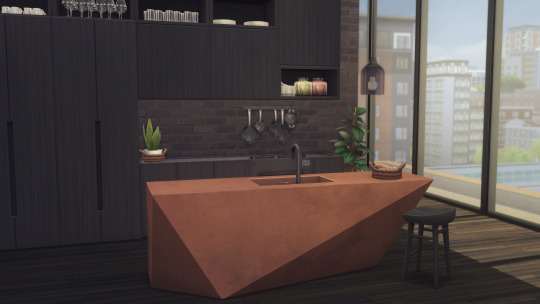
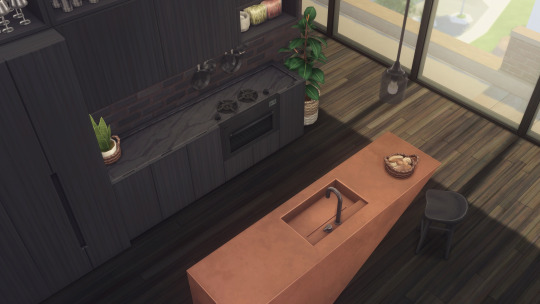
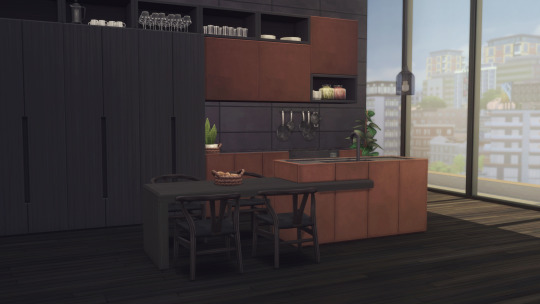


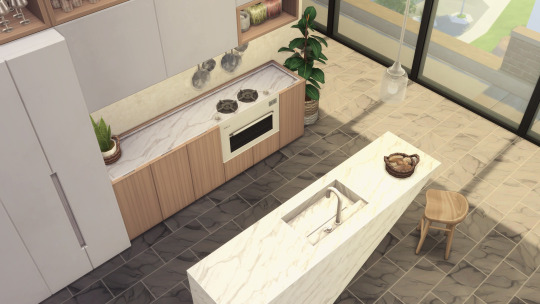
The Brownstone Collection - Part One
This set comprises of 21 items for the kitchen of your gorgeous New York Brownstone. The main focus of this month was to create a kitchen with clean minimal lines, and to take a few risks along the way. I knew that to achieve this sleek look, built in appliances were a must. There is a built in fridge that looks just like the tall wall cabinet, dishwasher, stove, oven & hob. Creating built in appliances comes with its owns set of challenges as appliances use a different shader in the game to counters, so they will never fully match, no matter what I do. Unfortunatley I can't apply the counter shader to appliances as it can't be used for an item with moving parts :( So I've used all the same texture and colours on the appliances, but also a series of metals, if the mismatch makes your eyes twitch.
NOTE: The stove, oven & hob slot into counters unlike the in game stoves. However you'll need to make sure you have auto counters off when placing, otherwise they are invisible. If you do use autocabinets, you only need to turn off to place them, they will stick around once auto counters are turned back on. But on a personal note...please never use auto counters, especially not with my kitchens that I've designed end pieces for 🙏
The bespoke shaped 3 piece kitchen island has been designed to fit either to be a prep space, fit in the new seamless sink or countertop hob into the middle section. It is not designed to slot in any of the other appliances and your regular appliances will poke out of the bottom.
There are tons of swatches in the counters and as a result I actually had to divide into 2 seperate counters. There are wood, paint and plaster options for the counter fronts and a choice of white marble, black marble, terrazzo and also matching plaster for the plaster front counters.
💡TIP: If your screen is a low resolution & the couter pieces run off the side of your screen, you'll want to try playing around with the filters to move the counters further to the r/h side of the catalogue ie. filtering by colour or pack.
I think thats everything for now, I'll let you discover all the rest on your own
ENJOY!!
EARLY ACCESS NOW AVAILABLE FOR $5 PATRONS
Public release follows on 8th April
4K notes
·
View notes
Text
Eight compact U-shaped kitchens designed by architects
In the latest in our series exploring kitchen layouts, we've picked eight examples from Dezeen's archive with U-shaped configurations to make efficient use of space.
As the name suggests, U-shaped kitchens consist of three worktops connected to form an open rectangle.
Popular in smaller interiors, the practical layout creates plenty of counter space for food preparation with room for storage underneath and in wall-hung cabinets above.
The design also creates a compact and efficient work triangle, with everything close to hand.
The U-shape is of the most common kitchen layouts along with one-wall kitchens, island kitchens, galley kitchens and peninsula kitchens.
This is the latest roundup in our Dezeen Lookbooks series providing visual inspiration for the home. Previous roundups include living rooms with statement shelving, spa-like bathrooms and home-working spaces.
Paris apartment, France, by Sophie Dries
French architect Sophie Dries combined two mid-19th-century flats in Paris to create a single large apartment.
At the centre of the apartment, this U-shaped kitchen combines dark grey floor and wall cabinets with soft red worktops, walls, floor and ceiling.
Find out more about Paris apartment ›
Delawyk Module House, UK, by R2 Studio
R2 Studio created playful interiors within this 1960s home on a London council estate. Set alongside an open-plan living and dining area, the bright kitchen combines yellow units and custom orange splashback tiles.
Countertops are arranged in a U-shape with the sink placed under a window and one arm of the U dividing the kitchen from the other communal areas.
Find out more about Delawyk Module House ›
Highgate apartment, UK, by Surman Weston
Built within a 1920s residential block in the Highgate, the kitchen and living space in this small apartment are connected by a timber-framed porthole window.
Within the small kitchen, the sink sits under a narrow window with turquoise-blue countertops inlaid with timber to create a terrazzo-like finish, positioned along the walls. The room is finished with cabinets made from fluted panels of oak finished with brass handles.
Find out more about Highgate apartment ›
Ruffey Lake House, Australia, by Inbetween Architecture
Local studio Inbetween Architecture overhauled a late 20th-century house in Melbourne to create a home for a family of five.
The ground floor was opened up to create an open-plan living and dining space that steps down to the kitchen. The cooker was located at the end of the U with the sink on one arm and space for food preparation on the other.
Find out more about Ruffey Lake House ›
Barcelona apartment, Spain, by Adrian Elizalde and Clara Ocaña
Spanish architects Adrian Elizalde and Clara Ocaña tucked the kitchen into a niche that was left over when they demolished the internal walls in this apartment in Barcelona's Eixample neighbourhood.
More of a J-shape than a U, the asymmetrical kitchen is defined by a tiled floor. The white countertop wraps around three walls and extends into the living area, which is demarked by timber flooring.
Find out more about Barcelona apartment ›
Carlton House, Australia, by Reddaway Architects
Lit by a skylight, the kitchen separates the more enclosed spaces in this house's original structure from a large open living and dining space within an extension.
The kitchen, which has a marble countertop above pink cabinets, extends out from the wall in a J-shape to create a partially enclosed food preparation and cooking space.
Find out more about Carlton House ›
The Cook's Kitchen, UK, by Fraher Architects
Fraher Architects added a black-stained timber extension to this London flat to create a larger kitchen for a client who loves to cook.
A window extends up the wall to meet a roof light that extends the length of the kitchen, which has a single, in-situ-poured concrete countertop.
The painted plywood cabinets feature patterns of randomly drilled holes that double as recessed handles.
Find out more about The Cook's Kitchen ›
HB6B – One Home, Sweden, by Karen Matz
Karen Matz created this kitchen within a small, 36-square-metre apartment that she designed for herself.
The end counter contains the sink and cooker, while one of the arms can be used as a breakfast bar. The third arm is topped with storage space and supports one side of the apartment's raised mezzanine bedroom.
Find out more about HB6B – One Home ›
This is the latest in our series of lookbooks providing curated visual inspiration from Dezeen's image archive. For more inspiration see previous lookbooks showcasing colourful interiors, outdoor fireplaces and rooftop gardens.
The post Eight compact U-shaped kitchens designed by architects appeared first on Dezeen.
1 note
·
View note
Text
The Lab Saving the World From Snake Bites
https://sciencespies.com/nature/the-lab-saving-the-world-from-snake-bites/
The Lab Saving the World From Snake Bites

In a patchy ten-acre tract of grass in Coronado, a hilly exurb northeast of the Costa Rican capital of San José, a weedy horse paddock and corrugated metal stable stand adjacent to a building of pristine laboratories and climate-controlled habitats. Through one door is a necropolis of dead snakes preserved in glass jars arranged helter-skelter on a counter, reminiscent of a macabre Victorian cabinet of curiosities. Through another is a sterile-looking white room full of humming scientific instruments.

A variety of snakes preserved at the Instituto Clodomiro Picado, in Costa Rica, a world leader in venom antidote production.
(Myles Karp)
The Instituto Clodomiro Picado, or ICP, named after the father of Costa Rican herpetology, is one of the world’s leading manufacturers of snake antivenoms, and the only one in Central America. The need for antivenoms is far more urgent than a person living in a developed nation blessed with a temperate climate might suppose. Globally, venomous snakebites kill roughly 100,000 people each year, mostly in South Asia, Southeast Asia and sub-Saharan Africa. In these regions’ poorer corners, local capacities for antivenom production are limited or nonexistent; the ICP has stepped in to help fill the gaps. Beyond meeting its own country’s needs, the institute has supplied or developed lifesaving antivenoms for victims on four continents, each treatment customized to protect against species that still pose lethal threats, from the West African carpet viper to the Papuan taipan.
At one time, snakebite deaths were common in Costa Rica, as Picado himself documented in his 1931 book Venomous Snakes of Costa Rica. He reported 13 in just one month—a death rate, given the population of about 500,000, higher than the current global death rate from lung cancer. Largely because of the ICP’s antivenoms, snakebite deaths in Costa Rica today are negligible, typically one or two per year in a current population of some five million—about the same per capita death rate as powered lawn mower accidents in the United States.
Celebrated for its abundance of tropical wildlife, Costa Rica is a place where it pays to watch your step. It is home to 23 species of venomous snakes, including the Central American bushmaster—one of the world’s largest vipers, growing up to 11 feet—and the bocaracá, whose indigenous name means “devil that brings death when it bites.” Yet none is more feared than Bothrops asper—the terciopelo, also known as the fer-de-lance. Across a range extending from Mexico to northern Peru, the terciopelo is dreaded for its tenaciously defensive temperament: In situations that would cause other vipers to flee, it strikes. And when the terciopelo bites, it injects a remarkable volume of venom, around ten times as much as a copperhead.

Among the most feared snakes to inhabit Central and South America is the terciopelo, or fer-de-lance, a venomous pit viper up to eight feet long.
(Alex Hyde)
For the stricken, the result is hellish. Terciopelo venom destroys the flesh at the injection site, causing severe swelling, tissue death and excruciating pain. As it travels through the body, it induces internal bleeding and, in severe cases, organ failure and death. Blood can seep out of the nose and mouth, among other orifices, which Mayans compared to sweating blood. Picado described the late stages of such a snakebite this way: “If we ask the wretch something, he may still see us with misted eyes, but we get no answer, and perhaps a last sweat of red pearls or a mouthful of blackened blood warns us of the triumph of death.”
* * *
“Are you scared?” asked the ICP snake handler Greivin Corrales, with a touch of concern and some mild amusement. I was standing in a small room with a six-foot-long terciopelo, unrestrained on the floor, only a few feet away from me. Corrales had witnessed me tense up when he removed the snake from a bucket with a hook; I had heard of the terciopelo’s reputation. Corrales’ colleague Danilo Chacón referred to the specimen as a bicho grande, using an untranslatable term that falls somewhere between critter and beast. The snake exhibited the characteristic scale pattern of diamond and triangles in light and dark brown, and the trilateral head that inspires the common name fer-de-lance, or lancehead. Though the snake was highly conspicuous on the terrazzo tiles, the markings would blend seamlessly with Costa Rica’s forest floor, making it all too easy to step on such a bicho.
The ICP has mastered the process of antivenom production, and I had come to watch the fundamental first step: the extraction of venom from a live snake, sometimes called “milking.”
The bucket from which the snake had been drawn was full of carbon dioxide gas, which temporarily sedates the snake, making the process less stressful for both animal and handler. Chacón, the more experienced handler, only recently started using carbon dioxide after nearly 30 years working with unsedated terciopelos. “I think it’s about not getting overconfident,” said Corrales. “Once you’re too confident, you’re screwed.” Even while occasionally handling unsedated snakes, the technicians use bare hands. “You have to feel the movement,” he said. “With gloves you don’t feel the animal, you don’t have control.”
The handlers bent down and picked up the groggy terciopelo, Chacón grabbing the head, Corrales lifting the tail and midsection. They led the snake headfirst to a mechanism topped by a funnel covered with a layer of thin, penetrable film, which the snake instinctively bit. Venom dripped from the fangs, through the funnel and into a cup. In its pure form, viper venom is viscous and golden, resembling a light honey.

One challenge of producing an antidote to snake venom is that you first have to produce the venom. Above, in the serpentarium at the Instituto Clodomiro Picado, Danilo Chacón and Greivin Corrales handle a live terciopelo, Bothrops asper, after sedating it with carbon dioxide gas. The men don’t wear bite-resistant gloves because they want to feel the snake move. Above right, when they place the fangs through a film stretched over a collection tube, the reptile’s venom glands, located below its eyes, discharge the honey-colored venom through ducts, out the fangs and, far right, into a cup. Small amounts of such venom will be repeatedly injected into a horse over several months, and the horse’s immune system will generate antibodies to the venom that will serve as the basis of an antivenom treatment. Left, Chacón and Corrales open the snake’s mouth to reveal its tongue and substantial fangs.
(Myles Karp)
Antivenoms were first developed at the end of the 19th century by the French physician and immunologist Albert Calmette. An associate of Louis Pasteur, Calmette was stationed in Saigon to produce and distribute smallpox and rabies vaccines to local people. Alarmed by a surge of fatal cobra bites in the area, Calmette—who later gained fame as an inventor of the tuberculosis vaccine—applied the principles of immunization and vaccination to snake venom. He injected serial doses into small mammals in order to force their bodies to recognize and gradually develop antibodies as an immune response to the toxins in the venom. In 1895, he began producing the first antivenoms by inoculating horses with Asian cobra venom, drawing the horses’ blood, separating the venom-resistant antibodies, and mixing them into a fluid that could be injected into a snakebite victim.

An institute staff member checks the temperature of a horse involved in generating antibodies to snake venom it has been exposed to. Technicians will collect the horse’s blood and separate off the antibody-rich plasma, which is purified, sterilized and packaged as an antivenom. The institute produces about 100,000 vials of antivenom annually, for treating people in Central and South America and sub-
Saharan Africa.
(The Instituto Clodomiro Picado)
Today, the ICP produces antivenoms in much the same way, but with more advanced processes allowing for a purer product. “Our antivenoms are basically solutions of horse antibodies specific against particular venoms,” said José María Gutiérrez, a former director of the ICP and a professor emeritus at the University of Costa Rica, which oversees the institute. The ICP’s roughly 110 horses live mostly on a farm in the nearby cloud forest and are brought to the stables to take part in antivenom production periodically. Venom is injected into a horse’s body in tiny amounts every ten days for two or three months initially, then once every two months—enough for its immune system to learn to recognize and create antibody defenses against the venom over time, but not enough to harm the horse. Afterward, blood is extracted from the horse in a quantity that is “like donating blood at a blood bank,” according to Gutiérrez. “We have the horses under strict veterinary control.”
Once the blood settles, the antibody-containing plasma is separated, purified, filtered, sterilized and mixed into a neutral liquid. The antivenoms are sent to hospitals, clinics and primary health posts, where they are diluted with saline and administered intravenously into snakebite victims.

Top, Clodomiro Picado, who was reared in Costa Rica and studied in France, was a zoologist, botanist and author of a 1931 book, left, about venomous snakes. He worked at a time when snakebites were a significant cause of death in Costa Rica. Far left, Albert Calmette, c. 1920, a French physician celebrated for his contribution to the tuberculosis vaccine, produced the first snakebite antidote in 1895, having studied venomous snakes while stationed in Saigon for the Pasteur Institute.
(The Instituto Clodomiro Picado (2); © Institut Pasteur – Musée Pasteur)
Antivenom counteracts venom precisely on a molecular level, like a lock and key. Because venoms vary chemically among species, an antivenom to protect against a specific snake’s bite must be prepared with venom from that snake, or from one that has very similar venom. To produce an antivenom that protects against multiple species, called a “polyvalent,” different venoms must be combined strategically in production. “That specificity makes anti-venoms sort of difficult to produce,” said Gutiérrez. “In contrast, tetanus antitoxin is the same all over the world, because tetanus toxin is a single toxin.”
The ICP maintains a diverse collection of live snakes, mostly caught and donated by Costa Rican farmers and landowners, some bred in captivity. From these, the ICP technicians have built an impressive stock of extracted venoms, supplemented with occasional imports of exotic venoms.
“Venom, more venom, and more venom there,” said serpentarium coordinator Aarón Gómez, opening a freezer in a laboratory room, exposing dozens of samples. After extraction, most of the venoms are immediately dehydrated for preservation. He unscrewed the top of a plastic container the size of a spice jar, revealing contents that looked like yellow ground mustard powder. “That’s terciopelo venom,” he said. “We have 1.5 kilos,” he said with raised eyebrows. That’s enough to kill 24 million mice or probably thousands of people.
The snakes that produce the world’s most potent venoms inhabit deserts, tropical forests and warm seas. Many pose a grave threat to people, but others are seldom encountered. Below the map, learn about ten of the most lethal snakes, ranked in descending order by venom potency. —Research by Katherine R. Williams

(Eritrea Dorcely)
Enhydrina schistosa

(Alamy)
Lethal venom dose*: 0.6 micrograms
Venom yield**: 79 milligrams
Common name(s): Beaked sea snake, hook-nosed sea snake, Valakadyn sea snake
This highly aggressive species kills more humans than any other sea snake. Its venom is so potent that one animal may carry enough to kill as many as 22 people.
*Estimated amount of venom, in micrograms, to kill 50 percent of laboratory mice in a sample, if each mouse weighed 30 grams. A microgram is 0.001 milligram, roughly the mass of a single particle of baking powder.
**Maximum amount of venom, dried, in milligrams, produced at one time by an adult snake.
The ICP’s success in maintaining and breeding snakes that otherwise fare poorly in captivity has allowed for the collection to include workable quantities of exceedingly rare venoms. For example, an innovative technique involving a diet of tilapia filets sustains about 80 coral snakes in the serpentarium, a rare quantity. “Most other producers don’t produce coral antivenom,” said Gómez. “But because we have the snakes, we can produce the venom, so we can produce the antivenom.” A potent neurotoxin, coral snake venom is about four times as lethal as terciopelo venom. In powdered form, it is pure white.
* * *
There’s no question that historical factors like accessible health care, the migration from rural to urban areas, and even a decrease in barefootedness contributed to the decline of snakebite deaths in Costa Rica. But without the ICP’s antivenoms, bites would still carry a grave risk. Traditional remedies popular before the proliferation of antivenoms—such as drinking an elixir of tobacco leaf or rubbing a bone on the bite—were no match for snake venom.

At a Doctors Without Borders clinic in Abdurafi, Ethiopia, a 24-year-old farmworker received antivenom after a snake bit her on the forehead as she slept.
(MSF)
Other countries, however, cannot claim such progress. India alone suffers nearly 50,000 venomous snakebite fatalities each year, chiefly from the saw-scaled viper, the Indian cobra, Russell’s viper and the common krait. Nigeria’s snakebite mortality rate has been reported at 60 deaths per 100,000 people—more than five times the mortality rate from automobile accidents in the United States.

A combination snakebite treatment produced by the Costa Rican institute consists of antibodies to three venomous snakes that inhabit sub-Saharan Africa.
(Susanne Doettling / MSF)
“We want to expand the knowledge and expertise generated in Costa Rica to contribute to solving this problem in other regions and countries,” said Gutiérrez, who is also a member of the board of directors of the Global Snakebite Initiative, a nonprofit that advocates for greater recognition and understanding of snakebite mortality worldwide, especially in impoverished regions. Since the near-eradication of snakebite deaths in Costa Rica, the ICP has endeavored to fill antivenom vacuums in these faraway places where antivenoms have been inadequate, inaccessible or nonexistent.
Even the United States, with its advanced medical science and robust pharmaceutical industry, has experienced occasional antivenom shortages. Despite the exorbitant prices for which the product can be sold in the U.S.—generally over 100 times what ICP antivenoms go for—the relative rarity of venomous bites and the esoteric, labor-intensive manufacturing process have kept antivenom production a niche industry there. Only two entities in the United States currently produce snake antivenoms for human use: Pfizer (to counteract coral snake venom) and Boston Scientific (to counteract pit vipers like rattlesnakes).

Clark’s coral snake, native to rainforests in parts of Costa Rica, Panama and Colombia, is nocturnal and doesn’t often trouble people. ICP scientists have decoded its venom and found three toxic compounds.
(Alamy)
That leaves labs like the ICP fulfilling the supply of antivenoms where the demand is greatest. Founded in 1970, ICP began steadily furnishing the drugs to other Central American countries in the 1990s. To develop new antivenoms for regions in need, in the early 2000s it began importing foreign venoms with which to inoculate its own horses; the institute doesn’t import live snakes because of ecological and safety concerns.
For a decade the institute has been distributing a newly developed antivenom to Nigeria, capable of protecting against the venoms of the West African carpet viper, the puff adder and the black-necked spitting cobra. Bites from these deadly snakes had been treated in the past mostly with a polyvalent antivenom manufactured by Sanofi-Pasteur, but the French pharmaceutical giant, citing a lack of profit, ceased production in 2014, leaving a dangerous gap in the market. The ICP’s antivenom is now being used in other countries in the region, from Burkina Faso to the Central African Republic. “Doctors Without Borders is now using our antivenom at their stations in Africa,” said Gutiérrez.

Named for the unusual scales protruding from its head, the eyelash viper is a venomous tree snake found from southern Mexico to Venezuela.
(The Instituto Clodomiro Picado)
“The Instituto Clodomiro Picado has been doing this production for many, many years, and they’ve got it dialed in,” said Steve Mackessy, a biochemist from the University of Northern Colorado, who has collaborated with the institute. “They produce an affordable product that works very, very well. So applying that to a situation where you have anti-venoms that either weren’t available at all, or were poor quality, or poor efficacy because they’re mostly designed against other species, that’s a godsend for those countries.”
An estimated 250,000 people have been treated with ICP’s antivenoms in Central America, South America, Africa and the Caribbean. The institute has recently developed new products for Asia, specifically Papua New Guinea—home to the extremely venomous taipan—and Sri Lanka, where imported Indian antivenoms used there have been described as largely ineffective.

The largest venomous snake in the New World is the bushmaster—here, the Central American species, which may grow to 11 feet. Its inch-long fangs inject prey with copious venom.
(The Instituto Clodomiro Picado)
Antivenoms may not be a lucrative business, but Gutiérrez stresses that access to such essential medicines should be considered a human right rather than a commodity. “This is a philosophical issue here,” he said. “Any human being that suffers snakebite envenomation should have the right to receive an antivenom.”
* * *
Clodomiro Picado himself—whose imposing bust adorns a sign outside the ICP’s entrance—was not generous in his estimation of the character of snakes. “He who dies victim of snakes does not fight, his death won not by conquest but by thievery,” he wrote. “For this reason the serpent, together with poison and the dagger, are signs of treachery and treason.” Gutiérrez is more measured, pointing out that snakes have been both gods and demons in mythologies around the world: “They’re fascinating, yet they can kill you.”
#Nature
2 notes
·
View notes
Photo

Modern Kitchen - Kitchen
#A mid-sized modern galley kitchen remodel idea with a medium tone wood floor#an undermount sink#flat-panel cabinets#white cabinets#stainless steel appliances#no island#terrazzo countertops#a white backsplash#and a stone tile backsplash. white high gloss cabinets#modern compact kitchen#white galley kitchen#white terrazzo counter#compact kitchen layout#galley kitchen ideas#white terrazzo countertop
0 notes
Text
Bars and Cafes in Italy - the BEVERAGES
The foreign custom of ‘going out for a drink’ isn’t particularly popular in Italy, where most people consume alcohol only with meals. Nevertheless, bars and cafés are plentiful and they're an essential part of daily life.
There’s an ever-increasing range of bars and ‘pubs’ springing up throughout the country; in Rome alone, there are many hundreds. Most bars are similar in appearance – a pristine chrome bar, bright lights and a photograph (or two) of the local football team on the wall – they serve snacks and ice cream as well as drinks all day. When you enter a bar, your first decision is whether to stand or sit; once you’ve chosen, there’s no going back! Table (tavola) or terrace (terrazzo) service is usually 2x as expensive as standing – a tariff list (listino prezzi) must, by law, be posted behind the bar. If you choose to stand, you order from the cashier (cassa), who gives you a receipt (scontrino) that you present to the bartender, although in smaller bars you may be able to order first and pay when you leave. If you decide to sit, you will wait to be served. It isn’t done to order from the cashier and then sit down; if you do, the waiter will have his suspicions about your nationality confirmed instantly!
Hot Drinks
Coffee (caffè) is an institution in Italy and is served in many ways. Among the most common are:
Espresso – a small, very strong black coffee;
Caffè lungo – also small and black, but weaker;
Corretto – black mixed with a liqueur, usually grappa;
Macchiato – black with a spoonful of milk ‘foam’ on top;
Caffè latte – large with lots of milk;
Cappuccino or cappuccio – with cream and chocolate on top, often served lukewarm and drunk only for breakfast or between meals (only foreigners insist on it being served after dinner!).
A Decaffeinato usually consists of a sachet of decaffeinated coffee and a cup of warm milk (decaf isn’t popular in Italy). Some names for coffee vary from region to region, although none have much in common with the pale imitations dished up in many other countries. An espresso costs around €0.80 and a cappuccino around €1.25.
Italians aren’t great tea drinkers and, if you ask for tea, you should be prepared to receive a glass of lukewarm water with a teabag beside it. If you want proper tea, ask for boiling water (molto caldo/bollente) and bring your own teabag! Other hot drinks include chocolate (cioccolata), which is thick enough to eat with a spoon.
Beer & Wine
Beer is popular with Italians, particularly among the younger generation; British and Irish-style pubs have mushroomed in recent years. Italian beers include Moretti, Frost and Peroni, which are served in bottles or on draught (alla spina). Prices average around €1.50 for a small (piccola, 20cl) beer, €2 for a medium (media, 40cl) beer, €2.75 for a large (grande, 66cl) – although prices depend very much on establishment and whether you sit or stand - you may pay up to €5. Beers from a wide range of other countries are also widely available.
Wine (vino) is served by the glass and around €1-€1.50, although you can pay up to €12 for a glass of vintage wine in a wine bar.
Other Drinks
Non-alcoholic drinks include granita, an ideal summer drink made with fresh lemon or other fruit juice and crushed ice. Carbonised drinks are also popular throughout Italy, where bars and cafés are obliged (by law) to provide a free glass of tap water for anyone who wants it, irrespective of whether you buy anything else.
Food
Bars usually serve a wide range of snacks, from sandwiches to basic hot meals. Snack bars (paninoteche) specialise in made-to-order sandwiches with a vast choice of fillings, which are usually displayed behind the counter. The different sandwiches available include:
Tramezzino – thin white sandwich bread cut into triangles;
Panini – crusty, French-style bread stick;
Schiaccitta schiacciata – large, round salted cracker which, when filled, is cut into portions;
Toste toast or tost – a toasted sandwich, which in bars is usually limited to cheese and/or ham.
98 notes
·
View notes
Text
The 5 best midcentury modern homes for sale right now
In our House of the Day column, we cover a plethora of gorgeous homes, from elegant Gilded Age mansions to show-stopping new builds. But time and time again, some of our favorite homes for sale are of the midcentury variety.
They range in style and authenticity; some homes built in the 1950s and 1960s have been tastefully updated, while others are time capsules for the midcentury purist. We also write about midcentury modern homes from around the country—not just in ultra-hip epicenters like Palm Springs—and at all price points. Whether you’re on the hunt for a new pad or just like to window shop, here are five swoon-worthy midcentury homes on the market to check out right now.
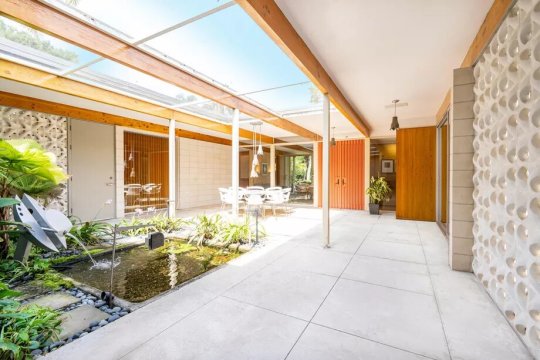
Guests are welcomed to the Sarasota School home through an interior courtyard with pond. Photo by Glenn Johnson of Coastal Photography
Restored midcentury gem near the beach
Price: $1,695,000
Details: One of the latest Sarasota School houses to catch our eye is this three-bedroom, three-bath home in Sandy Hook, a private beachfront neighborhood on the island of Siesta Key. Siesta Key is packed with gorgeous midcentury architecture by Paul Rudolph, Victor Lundy, and Frank Folsom Smith, but this 2,550-square-foot home was designed by Siebert Architects—Sarasota’s oldest architecture firm.
The 1962 home has all the midcentury details we love, like long horizontal lines, glass walls, clerestory windows, and terrazzo floors. A covered interior courtyard features a pond, skylights, and a large dining table for entertaining, and exposed beams throughout the house contrast with the bright, airy windows. See more, over here.

Designed and built in 1965 by architect Allan Gelbin, the home follows Frank Lloyd Wright’s theories on organic architecture. Photos by Austin Eterno
A Connecticut home by a Frank Lloyd Wright apprentice
Price: $625,000
Details: This five-bedroom, two-and-a-half-bath home in Weston, Connecticut, was designed and built in 1965 by architect Allan Gelbin. Gelbin was an apprentice to Frank Lloyd Wright at Taliesin East in Spring Green, Wisconsin, from 1949 to 1953, before establishing his own practice in 1957 in Connecticut.
The focal point of the design is an expansive living room and dining room that features a stone fireplace. Clerestory windows let in light, while wooden ceiling panels and built-in bookshelves add coziness. Floor-to-ceiling glass windows showcase a wraparound deck and views of the 2.25-acre property, and the master suite also offers panoramic views and access to a terrace. You can see more photos, this way.

The A-frame style living room features walls of glass, a fireplace, exposed beams, and amazing ocean views. Photo by Marc Weisberg
Oceanfront home by Frank Lloyd Wright apprentice
Price: $14,900,000
Details: Designed by Frank Lloyd Wright apprentice Frederick Liebhardt in 1958, this four-bedroom, eight-bath oceanfront home is located above Windansea beach, an iconic surf spot made famous in the 1960s in Tom Wolfe’s nonfiction collection The Pump House Gang.
Liebhardt designed the home as a personal residence for his mother, and the house has seen two subsequent renovations—one remodel by midcentury modern architect Henry Hester and a more recent one by Hill Construction and NYC designer Eddie Lee. The house is now 6,338 square feet with a stunning A-frame living room. Huge walls of glass provide unobstructed ocean views, and the way the home is situated on its one acre lot means that you can’t see your neighbors. Find more photos, over here.
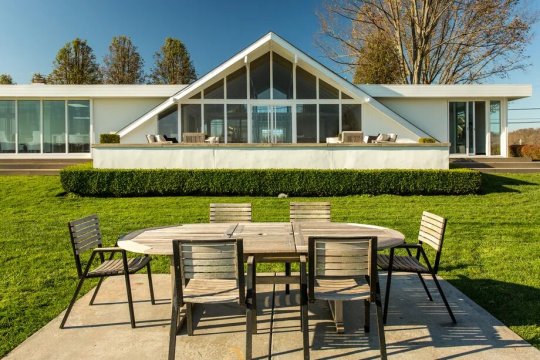
This Swiss Miss home in Pennsylvania was designed in 1958 by noted midcentury architect Jules Gregory. Michael Hirsch for Kurfiss Sotheby’s International Realty
Dazzling A-frame in Pennsylvania
Price: $3,495,000
Details: Midcentury modern homes might be known for their butterfly roofs, but the style also popularized the Swiss Miss A-frame. And while you might expect A-frames in mountain towns or midcentury hotbeds like California, check out this three-bedroom, four-bath home in New Hope, Pennsylvania. Built in 1958 by noted midcentury architect Jules Gregory, the low-lying home is bifurcated by a steep, dramatic A-frame roof that rises straight from the ground.
Inside, the A-frame creates a dramatic double-height living room with floor-to-ceiling windows that look out onto the 1.42-acre property. Recent renovations brought a more contemporary feel to the space; gloss-black hardwood floors contrast with white walls, beams, and counters. Other perks include a 16-foot kitchen island, large closets, and a rear patio with bar, BBQ, fire pit, and pool. See the interiors, over here.
The living room features floor-to-ceiling windows—a Sarasota School trademark—and an Ocala brick wall. Photo by Glenn Johnson, Coastal Photography
Beachfront midcentury time capsule
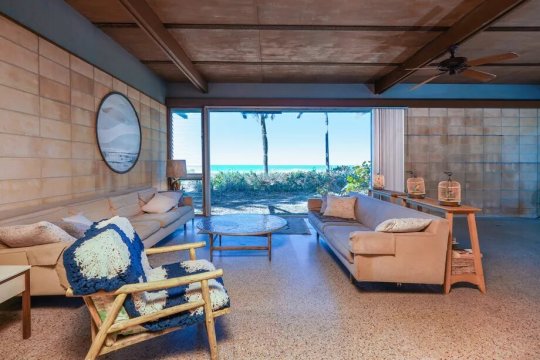
Price: $1,900,000
Details: This four-bedroom, four-bath rarely seen home was the writer’s studio of Walter Farley—author of the Black Stallion book series—and was designed by Sarasota architecture icons Ralph Twitchell and Jack West. It’s a time capsule in the truest form, with original details like Ocala block construction, clerestory windows, and mahogany louvers that let in the ocean breeze.
Reference - https://www.curbed.com/2020/2/14/21136376/midcentury-modern-best-homes-for-sale
1 note
·
View note
Photo

#goodmorning 〰️ an oatmeal flat white on that terrazzo counter top please! 〰️ that coffee shop is on my list of many places to visit 〰️ @synonymshop (at SYNONYM) https://www.instagram.com/p/B4g_6x1ow9O/?igshid=1xp73e8up3hog
1 note
·
View note